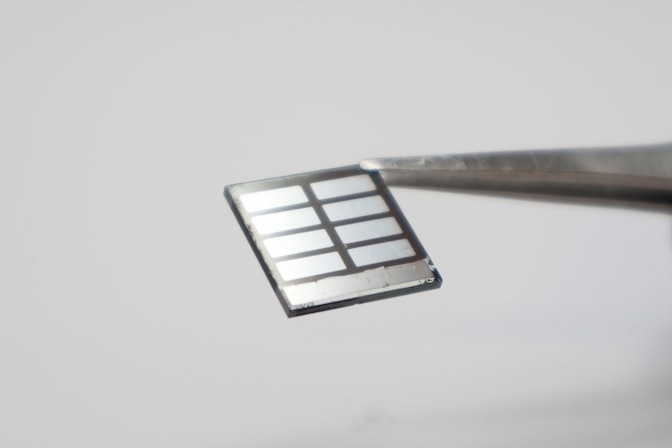A breakthrough at the University of Michigan, revealing ways to prevent the rapid degradation of perovskite semiconductors, holds the potential to facilitate the development of solar cells that are estimated to be two to four times more cost-effective than current thin-film solar panels.
 Perovskite solar cells like this one, made by Xiwen Gong’s group, could make solar energy cheaper and more environmentally friendly - but they degrade faster than silicon. In a study published in the journal Matter, the team discovered how to make the black perovskite film last longer. Image Credit: Zhengtao Hu, Gong Lab, University of Michigan.
Perovskite solar cells like this one, made by Xiwen Gong’s group, could make solar energy cheaper and more environmentally friendly - but they degrade faster than silicon. In a study published in the journal Matter, the team discovered how to make the black perovskite film last longer. Image Credit: Zhengtao Hu, Gong Lab, University of Michigan.
The integration of perovskites with the prevalent silicon-based semiconductors found in current solar panels may lead to the creation of "tandem" solar cells. These cells have the potential to surpass the maximum theoretical efficiency of silicon solar cells.
Silicon solar cells are great because they are very efficient and can last for a very long time, but the high efficiency comes with a high cost. To make high-purity silicon, temperatures over 1,000 degrees Celsius are needed. Otherwise, the efficiency won’t be as good.
Xiwen Gong, Assistant Professor, Chemical Engineering, University of Michigan
Costs to the environment and economy are increased by the high temperature. Perovskites can be made at lower temperatures, but heat, moisture, and air cause them to break down. Consequently, perovskite’s lifespan is currently too short for solar panels to be competitively manufactured.
In an effort to create more durable perovskite solar cells, Gong’s recent research, which was published in the journal Matter, indicates that large, “defect pacifying” molecules are the most effective in extending the stability and lifespan of the perovskites.
Lead atoms found in perovskite crystals are partially unbound from the other constituents. Defects known as “undercoordinated sites” are frequently observed at grain boundaries, where the crystal lattice breaks, and on the surfaces of crystals. These flaws accelerate the perovskite material’s decay by obstructing electron flow.
Engineers are already aware that adding molecules that calm defects to the perovskites can aid in locking up the lead that is not coordinated well, which in turn keeps other flaws from developing at high temperatures. However, until now, engineers were unsure of the precise way in which a particular molecule impacted the durability of perovskite cells.
We wanted to figure out what features on the molecules specifically improve the perovskite’s stability.
Hongki Kim, Former Postdoctoral Researcher and First Author, Chemical Engineering, University of Michigan
To explore the issue, Gong’s group produced three different sized and shaped additives and incorporated them into thin films of perovskite crystals, which have the ability to absorb light and produce electricity. The primary characteristics that set each additive apart were their size, weight, and arrangement because the additives all contained the same or comparable chemical building blocks.
The researchers then assessed the degree to which the various additives interacted with the perovskites and, as a result, affected the development of defects in the films. Because the additives had more binding sites that interact with perovskite crystals, larger molecules by mass were better at adhering to the perovskite. The additives consequently had a tendency to be more effective at stopping defects from developing.
However, the best additives also had to occupy a large amount of space. During the manufacturing process, the perovskite grains became smaller due to the large but skinny molecules. Because smaller grains produce more grain boundaries or places where defects can form, the smaller grains are not the best option for perovskite cells.
On the other hand, large molecules pushed the formation of larger perovskite grains, which decreased the density of grain boundaries in the film.
It was confirmed by heating the perovskite films to temperatures above 200 ºC that the use of bulky additives allowed the films to develop fewer structural defects and retain more of distinctive slate black color.
Both the size and configuration are important when designing additives, and we believe this design philosophy could be implemented across various perovskite formulations to further improve the lifetime of perovskite solar cells, light emitting devices, and photodetectors.
Carlos Alejandro Figueroa Morales, Doctoral Student and First Author, Macromolecular Science and Engineering, University of Michigan
Xiwen Gong is also an Assistant Professor of electrical and computer engineering, materials science and engineering, macromolecular science and engineering, and applied physics. The research was funded by the University of Michigan and relied on a scanning electron microscope funded by the National Science Foundation. Co-author Nancy Muyanja led the microscopy measurements at the Michigan Center for Materials Characterization.
Journal Reference:
Kim, H., et al. (2024) Molecular design of defect passivators for thermally stable metal-halide perovskite films. Matter. doi.org/10.1016/j.matt.2023.12.003.